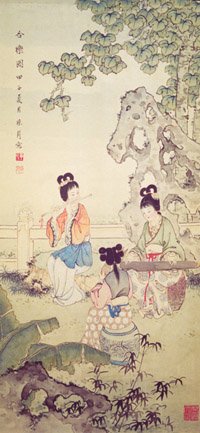
At the very start of Chinese race, there existed musical instrument. The very first Chinese musical instrument was created by Fu Xi (pronounced as "Fu Shyee"). Fu Xi was one of the originators of Chinese race and culture. He also created the Bagua (Eight Symbols). His living time should be at least 5000 years ago.
Chinese culture, like the ancient Greek culture, was a semi-divine culture at its early stage, in which gods were living together with humans and teaching culture to humans directly. Fu Xi was a god (divine being).
 |
| Wu Tong tree. |
Fu-Xi chose the trunk of Wu-tong Tree (Phoenix Tree or Chinese Parasol) to make the musical instrument. Phoenix does not stay on any other trees except Wu-tong Tree. Phoenix is regarded as the King of all birds of different species. So Fu Xi regarded that Wu-tong must be the divine species among all types trees, and it should be the right type of wood to make a musical instrument that can create elegant music.
|
Get meaningful Chinese name for westerners
|
Fu Xi cut the Wu-tong tree trunk into three segments. He knocked at the top segment and found the sound was too clear. He knocked at the bottom segment and found the sound was too thick. Therefore, He picked the middle segment that has a sound being neither too clear nor too thick.
He put the segment of wood into a constantly flowing water current for seventy-two days before taking it out. Then he picked a date of good fortune and invited a skillful craft worker to make it into a musical instrument. The worker did not know how to make it. Fu Xi told him to make the length 3 feet 6 inches and 1 Fen in order to match the number of degrees in a circle. The width of the musical instrument was 8 inches at one end and 4 inches at the other end in order to match the number of terms and seasons in a year. He put five strings on it to match the Five Elements of Metal, Wood, Water, Fire and Soil. In Zhou Dynasty, the number of strings was increased to seven.
This kind of musical instrument is now called Guqin (pronounced as goo-chyin), which means "Ancient Musical Instrument".
Chinese music was often addressed as "Virtue Music", "Elegant Music" and "Etiquette Music" in ancient times. In ancient Chinese society, music was not regarded as a way of entertainment, but as a practice to refine one's virtue. Playing Guqin (Ancient Stringed Musical Instrument) was regarded as one of the primary skills that a scholar had to learn. Chinese traditional culture intensively emphasizes that a musical instrument player pay attention to one's heart state and virtue, and that one cannot play musical instrument casually.
In terms of the occasions of playing Guqin (Ancient Chinese Musical Instrument), there are "Six Avoidances" and "Seven Should-Not-Plays".
 | |
| "The Picture of Instrumental Ensemble" by modern traditional Chinese artist Ms. Zhang Cuiying. |
"Six Avoidances" in playing Ancient Chinese Musical Instrument:
"Seven Should-not-plays" regarding playing Ancient Chinese Musical Instrument:
So if you take a mindset of listening modern music, you may feel Chinese traditional music is too plain. However, if you can really make your heart peaceful and tranquil, you will feel the meanings of Chinese traditional music. At that kind of tranquil and rational mind state you will find that one's joy and other sentiments and feelings are more real.
In western music, there are seven musical notes "do re mi fa sol la si", while Chinese traditional music only uses only five music notes "do re mi sol la". These five notes correspond with the Five Elements "Soil, Metal, Wood, Fire, Water". Without "fa" and "si", in Chinese music scale there is no half-tone. The effect is that Chinese traditional music normally is not likely to create unstable and unharmonious sound or chords.
Comparing with western classical music, Chinese music did not use chord and did not emphasize the arrangement for orchestra. In Chinese traditional music there was also ensemble of many musical instruments. However, it was often simultaneous playing or some musical instrument taking the lead in different section.
Chinese classical stories on understanding music wellThere was some well-known stories in Chinese culture about the mutual understanding between musical instrument players and listeners.
Cai Yong (蔡邕) was a famous litterateur in East Han Dynasty. He offended a high official of Royal Court because of raising political criticism. Since then, he was escaping here and there to avoid being framed and murdered. Once he returned to his home town and his old neighbor invited him to dinner. He went to the dinner and heard someone playing musical instrument. At one moment he felt the music being played carried some killing connotation. He was worried that maybe someone wanted to kill him at the dinner, so he turned back and ran away immediately. However, the host was so sincere that he caught up with Cai Yong and dragged him back. The host asked why he ran away and Cai Yong told the host of his feeling with the music. Later the player explained that he saw a mantis approaching a cicada outside the window during his playing. He wished the mantis could succeed in catching the cicada, and this thought was manifested in the playing of the music. All people who were present at the dinner highly praised Cai Yong's good understanding of music. Another story. Yu Boya was a well-achieved musician and a high official in the period of Spring and Autumn (770 AD - 403 AD). Yu Boya was playing in a boat that was parking beside a hill at night. However, one of the strings was broken during his playing. Yu Boya said, the sudden change of the sound of musical instrument indicated that there must be someone hidden nearby. Then Zhong Ziqi, a woodsman, greeted him from the bank. Yu Boya invited Zhong Ziqi onto the boat. Boya played a piece of music with his mind thinking of high mountains. Ziqi, after listening, said the meaning of the music was about high mountains. Boya played another piece of music with his mind thinking of flowing water. After Boya stopped, Ziqi said his music was about flowing water.Because Zhong Ziqi was so good at understanding Boya's playing, Boya and Ziqi became sworn brothers and Boya promised to come back to meet Ziqi a year later. The next year, Boya came back to meet to Ziqi. However, Ziqi had died. Boya played at Ziqi's grave. After his playing other neighbours at the grave did not understand his music at all. They, regarding the music as entertainment, clapped and laughed. Yu Boya was so sad that he smashed his musical instrument on a rock. Click here to download the famous classical Chinese music that Yu Boya played -- "High Mountain and Flowing Water". | |||||||||||||||||||||
Some typical Chinese Musical Instruments
|
Musician's Friend Gift Certificates. Give the gift that rocks!
Go to top of page "Chinese Musical Instrument"